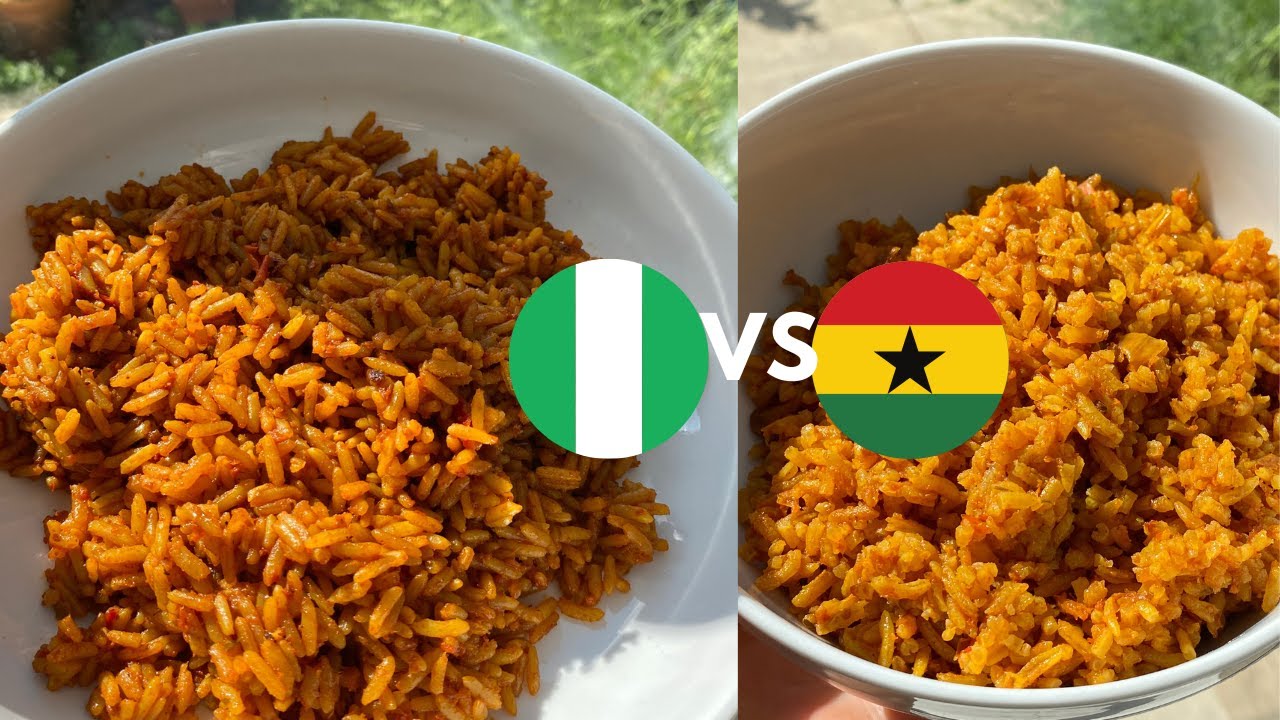
If you’re even mildly familiar with West Africa—or you’ve scrolled through #JollofWars on Twitter—you’ve probably come across heated debates about a dish that ignites both national pride and friendly fire: Jollof Rice.
At first glance, Jollof might look like just a rice dish cooked in red sauce. But behind the grains and the rich tomato base lies a centuries-old culinary tradition, a tapestry of history, identity, and culture that transcends borders. From Senegal to Nigeria, Ghana to Cameroon, Jollof has been adapted, reimagined, and passionately defended.
So, where exactly did Jollof Rice come from? Is it Nigerian? Ghanaian? Or does it truly belong to Senegal—the place many food historians point to as its original homeland?
Let’s dig in.
The Origins of Jollof Rice
The story of Jollof Rice begins not in Nigeria or Ghana, but in Senegal, where a dish called Thieboudienne (also spelled ceebu jën in Wolof) laid the culinary foundation for what we now call Jollof. Thieboudienne, which translates to “rice with fish,” originated with the Wolof people, who gave Jollof its name.
During the 14th century, the Jolof Empire spanned much of present-day Senegal and The Gambia. This empire is considered the birthplace of the dish that would go on to conquer West Africa. At the time, trade routes opened up the movement of tomatoes, rice, and spices. Rice, in particular, was a staple crop along the Senegal River Valley. With access to Atlantic trade, tomatoes—introduced from the Americas—eventually found their way into local stews, giving birth to the red, tomato-based rice dish.
As people migrated across the region and colonial borders redrew themselves, this dish evolved. It traveled from kitchen to kitchen, kingdom to colony, and culture to culture—picking up new flavors and techniques along the way.
The Evolution of Jollof Rice Across West Africa
By the 19th and 20th centuries, Jollof Rice had spread beyond Senegal and into the culinary traditions of countries like Nigeria, Ghana, Sierra Leone, Liberia, Cameroon, and The Gambia. Each region added its unique spin—changing the proteins, vegetables, spices, and even the type of rice used.
Senegalese Jollof (Thieboudienne) tends to be more elaborate. Cooked with broken rice, vegetables like carrots, eggplant, and cabbage, and fish, it’s rich and deeply flavorful. It’s usually prepared in one pot and often includes fermented ingredients for a deeper umami.
Ghanaian Jollof, on the other hand, is known for its use of fragrant jasmine rice, a slight sweetness in its tomato base, and a smokier taste due to long cooking over low heat. Ghanaian cooks often incorporate bay leaves, cloves, nutmeg, and green bell peppers for complexity.
Nigerian Jollof is bold, spicy, and deep red. Long grain parboiled rice is typically used, and the tomato-pepper base (made with tomatoes, scotch bonnet peppers, onions, and oil) is fried until rich and aromatic before the rice is added. The dish is often served with fried plantains, salad, grilled or fried chicken, beef, or moi moi (steamed bean pudding). Nigerians typically use seasoning cubes like Maggi or Knorr and believe in “party rice”—cooked over firewood for that slightly smoky, toasty flavor.
The Jollof Wars: More Than Just Rice
While Jollof is a shared cultural treasure, it has also become a humorous but passionate battleground—especially between Nigeria and Ghana. Social media often erupts into friendly fire when influencers, food bloggers, and even celebrities weigh in on who makes the “best” Jollof.
In fact, even former President Obama and Facebook founder Mark Zuckerberg have been dragged (with a smile) into the debate after making offhand comments about West African food. There’s even a World Jollof Rice Day—celebrated on August 22—to honor the dish and stir the proverbial pot.
At Nigerian parties, Jollof is more than a meal—it’s a cultural expectation. Any wedding, birthday, or naming ceremony without Jollof Rice is considered incomplete. It’s not just food; it’s a symbol of hospitality, abundance, and love. If you’re invited to a Nigerian party and you leave without eating “party Jollof,” did you even attend?
Jollof has moved from a humble home-cooked meal to a national dish, a culinary flag, and a conversation starter. It’s a plate of pride.
Jollof as a Staple in Every Nigerian Home
In Nigeria, Jollof Rice is woven into the very fabric of domestic life. Many children grow up watching their mothers or aunties blend tomatoes, onions, and peppers in old-school blenders, watching the pot closely for the “fry down” stage when the oil separates from the tomato mix—a sign that the stew is ready to meet the rice.
It’s a go-to meal for Sunday lunch, served after church with fried chicken, soft drinks, and laughter. It’s what’s packed in coolers for road trips, for potlucks, for school lunchboxes, and even for comforting midnight cravings.
Its scent is unmistakable. Its taste? Nostalgic. Jollof is more than nourishment. It’s a memory in every bite.
Cooking Jollof: The Basics (With Flair)
While there are regional differences, most Jollof recipes follow a general process:
- Create the Base: Blend tomatoes, scotch bonnet peppers, red bell peppers, onions, and sometimes garlic and ginger into a smooth paste.
- Fry the Sauce: Cook the paste in oil (often vegetable oil or palm oil in some variants) with tomato paste until the oil separates and the sauce becomes rich and fragrant.
- Season Well: Add thyme, curry powder, bay leaves, bouillon cubes, salt, and pepper. Every family has their own seasoning secrets.
- Add the Rice: Washed or parboiled long grain rice is added and mixed thoroughly with the sauce.
- Simmer and Steam: Water or stock is added to the pot, and it’s covered tightly with foil or parchment paper under the lid to allow the rice to steam and absorb all the goodness.
- Optional Additions: Meats, vegetables, or smoked fish can be added depending on preference.
The magic happens when it all comes together—the rice absorbs the tomato stew, flavors deepen, and the bottom of the pot develops the crispy “party rice” that everyone fights over.
Whose Jollof is it Anyway?
While the Senegalese may lay claim to its origin, and Ghanaians insist theirs is the most balanced, Nigerians are often the loudest in proclaiming that theirs is the most flavorful. Truth be told, every country’s Jollof has its own charm, reflecting its people, palate, and personality.
Rather than focusing on who does it best, perhaps it’s better to see Jollof as a pan-African culinary journey. One dish, many stories.
As you travel through West Africa—or explore its cuisine from afar—you’ll see that Jollof tells a story about shared heritage, migration, creativity, and joy. It’s proof that food doesn’t just nourish the body—it connects people, cultures, and generations.
Come Taste Jollof in Its Homeland
If you truly want to understand Jollof, you need to taste it where it lives and breathes—on the streets of Lagos, in a bustling Abuja wedding hall, or at a family party in Port Harcourt. The warmth, the laughter, the aroma… it’s a full cultural immersion.
A trip to Nigeria is incomplete without indulging in a smoky plate of party Jollof, maybe paired with peppered chicken, moi moi, fried plantains, and a chilled drink. Whether you’re at a roadside eatery, a fancy restaurant, or someone’s home, you’ll be welcomed with flavors and smiles.
Our travel and tour packages offer authentic culinary experiences—from local cooking classes to food tours, from home-cooked meals to luxury dining. Come and experience the richness of Nigerian culture through its most iconic dish.
Final Thoughts: Jollof Is for Everyone
Whether you’re Nigerian, Ghanaian, Senegalese—or none of the above—Jollof belongs to all of us. It’s more than a dish; it’s a cultural ambassador, a unifying force, and a flavor-packed reminder of Africa’s diversity and brilliance.
So next time you see a Jollof debate online, smile, laugh, and maybe even join in. But better yet—book a trip to Nigeria and taste the difference for yourself.
Come for the Jollof. Stay for the culture.
#ExperienceJollof #TasteNigeria #Afrojolly







